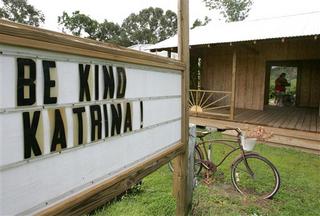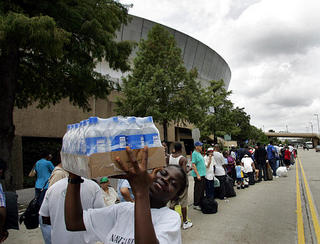KATRINA/ New Orleans braces for 'the big one'
NEW ORLEANS (CNN) -- A solemn New Orleans Mayor Ray Nagin ordered mandatory evacuations Sunday as his city faced its worst fear -- the threat of a direct hit from a major hurricane that could swamp the low-lying city.
Listen to the Mayor:By mid-morning Sunday, Katrina was a Category 5 hurricane with maximum sustained winds near 175 mph. It was expected to make landfall Monday morning. Category 5 is the most intense category on the Saffir-Simpson scale of intensity. (Full story)
Officials are particularly concerned about New Orleans because about 70 percent of the city is below sea level. The city essentially sits in a bowl, protected by a series of levies that keep the Mississippi River waters out. Nagin warned that Katrina's expected storm surge -- which could top 28 feet -- would likely topple those levies.
 "We are facing a storm that most of us have feared," Nagin said. "I don't want to create panic, but I do want the citizens to understand that this is very serious, and it is of the highest nature."
"We are facing a storm that most of us have feared," Nagin said. "I don't want to create panic, but I do want the citizens to understand that this is very serious, and it is of the highest nature."
Nagin said the city's shelters should be used as a last resort and said that people who use them should bring enough food, water and supplies to last for several days. He said that the Superdome, the city's main shelter, "is not going to be a very comfortable place at some point in time."
"The shelters will end up probably without electricity or with minimum electricity from generators in the end," Louisiana Gov. Kathleen Blanco said. "There may be intense flooding that will be not in our control which would be ultimately the most dangerous situation that many of our people could face."
Residents who had delayed their departure -- some not quite believing that Katrina could be the storm New Orleans authorities have always called "the Big One" -- jammed Interstate 10 westbound, prompting Blanco to urge evacuees to go north.
In worst-case scenarios, most of New Orleans would end up under 15 feet of water, without electricity, clean water and sewage for as long as six months. Even pumping the water out could take as long as four months to get started because the massive pumps that would do the job would be underwater.
without electricity, clean water and sewage for as long as six months. Even pumping the water out could take as long as four months to get started because the massive pumps that would do the job would be underwater.
Nagin also cautioned that the port of New Orleans handles much of the nation's oil transportation, meaning that an interruption in operations could have "a significant impact on the cost of oil." (Full story)
He said it would likely take weeks for the city to return to any semblance of normalcy if the worst comes to pass. Federal Emergency Management Agency teams and other emergency teams were already in place to move in as soon as the storm was over, FEMA Under Secretary Michael Brown said.
New Orleans, a city of nearly half a million with a metropolitan area population of 1.3 million, dodged a bullet in 1998 when a Category 2 Hurricane Georges had a last minute change of route and made landfall near Biloxi, Mississippi. But Georges was close enough to push the Mississippi River to within one foot of the top of the levees between the river and the city.
The last hurricane to score a direct hit on New Orleans was Hurricane Betsy, a Category 2 with 105 mph winds when it came ashore in 1965. Betsy killed more than 70 people, its storm surge overflowing the levees and reaching the eaves of many buildings.
 The levees are higher now, but Katrina is a stronger storm -- as strong as 1969's Hurricane Camille, which grazed New Orleans when it came ashore in Mississippi and killed more than 250 people.
The levees are higher now, but Katrina is a stronger storm -- as strong as 1969's Hurricane Camille, which grazed New Orleans when it came ashore in Mississippi and killed more than 250 people.
"After Betsy these levies were designed for a Category 3," said Sheriff Jeff Hingle of Placquemines Parish, just southeast of New Orleans. "You're now looking at a Category 5. You're looking at a storm that is as strong as Camille was, but bigger than Betsy was size-wise. These levies will not hold the water back. So we're urging people to leave. You're looking at these levies having 10 feet of water over the top of them easily."
Two category 4 storms, in 1909 and 1915, each killed hundreds in the area, and 1964's Hurricane Hilda killed 38.
But the deadliest storm to hit southeastern Louisiana was an unnamed storm in 1893 that killed an estimated 2,000 people.
 "We are facing a storm that most of us have feared," Nagin said. "I don't want to create panic, but I do want the citizens to understand that this is very serious, and it is of the highest nature."
"We are facing a storm that most of us have feared," Nagin said. "I don't want to create panic, but I do want the citizens to understand that this is very serious, and it is of the highest nature."Nagin said the city's shelters should be used as a last resort and said that people who use them should bring enough food, water and supplies to last for several days. He said that the Superdome, the city's main shelter, "is not going to be a very comfortable place at some point in time."
"The shelters will end up probably without electricity or with minimum electricity from generators in the end," Louisiana Gov. Kathleen Blanco said. "There may be intense flooding that will be not in our control which would be ultimately the most dangerous situation that many of our people could face."
Residents who had delayed their departure -- some not quite believing that Katrina could be the storm New Orleans authorities have always called "the Big One" -- jammed Interstate 10 westbound, prompting Blanco to urge evacuees to go north.
In worst-case scenarios, most of New Orleans would end up under 15 feet of water,
 without electricity, clean water and sewage for as long as six months. Even pumping the water out could take as long as four months to get started because the massive pumps that would do the job would be underwater.
without electricity, clean water and sewage for as long as six months. Even pumping the water out could take as long as four months to get started because the massive pumps that would do the job would be underwater.Nagin also cautioned that the port of New Orleans handles much of the nation's oil transportation, meaning that an interruption in operations could have "a significant impact on the cost of oil." (Full story)
He said it would likely take weeks for the city to return to any semblance of normalcy if the worst comes to pass. Federal Emergency Management Agency teams and other emergency teams were already in place to move in as soon as the storm was over, FEMA Under Secretary Michael Brown said.
New Orleans, a city of nearly half a million with a metropolitan area population of 1.3 million, dodged a bullet in 1998 when a Category 2 Hurricane Georges had a last minute change of route and made landfall near Biloxi, Mississippi. But Georges was close enough to push the Mississippi River to within one foot of the top of the levees between the river and the city.
The last hurricane to score a direct hit on New Orleans was Hurricane Betsy, a Category 2 with 105 mph winds when it came ashore in 1965. Betsy killed more than 70 people, its storm surge overflowing the levees and reaching the eaves of many buildings.
 The levees are higher now, but Katrina is a stronger storm -- as strong as 1969's Hurricane Camille, which grazed New Orleans when it came ashore in Mississippi and killed more than 250 people.
The levees are higher now, but Katrina is a stronger storm -- as strong as 1969's Hurricane Camille, which grazed New Orleans when it came ashore in Mississippi and killed more than 250 people."After Betsy these levies were designed for a Category 3," said Sheriff Jeff Hingle of Placquemines Parish, just southeast of New Orleans. "You're now looking at a Category 5. You're looking at a storm that is as strong as Camille was, but bigger than Betsy was size-wise. These levies will not hold the water back. So we're urging people to leave. You're looking at these levies having 10 feet of water over the top of them easily."
Two category 4 storms, in 1909 and 1915, each killed hundreds in the area, and 1964's Hurricane Hilda killed 38.
But the deadliest storm to hit southeastern Louisiana was an unnamed storm in 1893 that killed an estimated 2,000 people.


<< Home